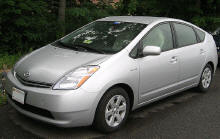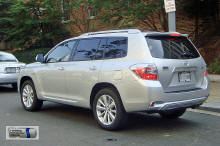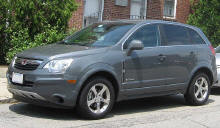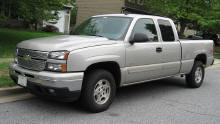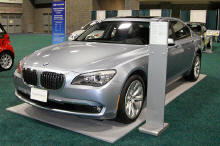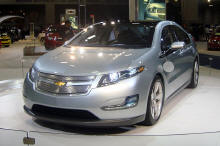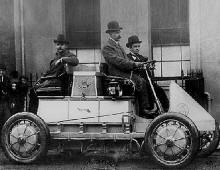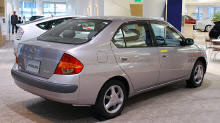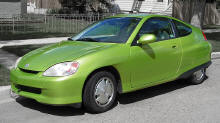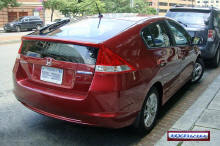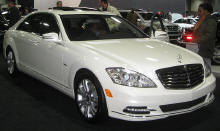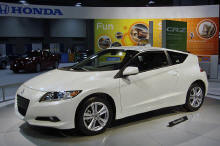Hybrid Electric Vehicle
|
A hybrid electric vehicle (HEV) combines a conventional internal combustion engine (ICE) propulsion system with an electric propulsion system. The presence of the electric powertrain is intended to achieve either better fuel economy than a conventional vehicle, or better performance. A variety of types of HEV exist, and the degree to which they function as EVs varies as well. The most common form of HEV is the hybrid electric car, although hybrid electric trucks (pickups and tractors) also exist.
Modern HEVs make use of efficiency-improving technologies such as regenerative braking, which converts the vehicle's kinetic energy into battery-replenishing electric energy, rather than wasting it as heat energy as conventional brakes do. Some varieties of HEVs use their internal combustion engine to generate electricity by spinning an electrical generator (this combination is known as a motor-generator), to either recharge their batteries or to directly power the electric drive motors. Many HEVs reduce idle emissions by shutting down the ICE at idle and restarting it when needed; this is known as a start-stop system. A hybrid-electric produces less emissions from its ICE than a comparably-sized gasoline car, as an HEV's gasoline engine is usually smaller than a pure fossil-fuel vehicle, and if not used to directly drive the car, can be geared to run at maximum efficiency, further improving fuel economy. Ferdinand Porsche in 1900 developed the Lohner-Porsche Mixte Hybrid, the first gasoline-electric hybrid automobile in the world. The hybrid-electric vehicle did not become widely available until the release of the Toyota Prius in Japan in 1997, followed by the Honda Insight in 1999. While initially perceived as unnecessary due to the low cost of gasoline, worldwide increases in the price of petroleum caused many automakers to release hybrids in the late 2000s; they are now perceived as a core segment of the automotive market of the future. Worldwide sales of hybrid vehicles produced by Toyota reached 1.0 million vehicles by May 31, 2007, and the 2.0 million mark was reached by August 31, 2009, with hybrids sold in 50 countries. Worldwide sales are led by the Prius, with cumulative sales of 1.6 million by early 2010. The global market leader is the United States with 1.6 million hybrids registered by December 2009, of which 814,173 are Toyota Prius, and California is the biggest American market.
Types of powertrainHybrid electric vehicles can be classified according to the way in which power is supplied to the drivetrain:
Types by degree of hybridization
Plug-in hybrids (PHEVs)A
plug-in hybrid electric vehicle (PHEV), also known as a plug-in
hybrid, is a hybrid electric vehicle with
Chinese battery manufacturer and automaker BYD Auto released the F3DM PHEV-62 (PHEV-100 km) hatchback to the Chinese fleet market on December 15, 2008, for 149,800 yuan (US $22,000). General Motors expects to launch the 2011 Chevrolet Volt series plug-in by November 2010. HistoryEarly daysIn 1900, while employed at Lohner Coach Factory, Ferdinand Porsche developed the Mixte, a 4WD series-hybrid version of "System Lohner-Porsche" electric carriage previously appeared in 1900 Paris World Fair. The Mixte included a pair of generators driven by 2.5-hp Daimler IC engines to extend operating range and it could travel nearly 40 miles on battery alone and it was presented in the Paris Auto Show in 1901. The Mixte broke several Austrian speed records, and also won the Exelberg Rally in 1901 with Porsche himself driving. The Mixte used a gasoline engine powering a generator, which in turn powered electric hub motors, with a small battery pack for reliability. It had a top speed of 50 km/h and a power of 5.22 kW during 20 minutes.
George Fischer sold hybrid buses to England in 1901; Knight Neftal produced a racing hybrid in 1902. In 1905, H. Piper filed a US patent application for a hybrid vehicle. The 1915 Dual Power, made by the Woods Motor Vehicle electric car maker, had a four-cylinder ICE and an electric motor. Below 15 mph (24 km/h) the electric motor alone drove the vehicle, drawing power from a battery pack, and above this speed the "main" engine cut in to take the car up to its 35 mph (56 km/h) top speed. About 600 were made up to 1918. A Canadian company produced a hybrid car for sale in 1915. The first gasoline-electric hybrid car was released by the Woods Motor Vehicle Company of Chicago in 1917. The hybrid was a commercial failure, proving to be too slow for its price, and too difficult to service. In 1931 Erich Gaichen invented and drove from Altenburg to Berlin a 1/2 horsepower electric car containing features later incorporated into hybrid cars. Its maximum speed was 25 miles per hour (40 km/h), but it was licensed by the Motor Transport Office, taxed by the German Revenue Department and patented by the German Reichs-Patent Amt. The car battery was re-charged by the motor when the car went downhill. Additional power to charge the battery was provided by a cylinder of compressed air which was re-charged by small air pumps activated by vibrations of the chassis and the brakes and by igniting oxyhydrogen gas. An account of the car and his characterization as a "crank inventor" can be found in Arthur Koestler's autobiography, Arrow in the Blue, pages 269-271, which summarize a contemporaneous newspaper account written by Koestler. No production beyond the prototype was reported. Predecessors of current technologyA more recent working prototype of the HEV was built by Victor Wouk (one of the scientists involved with the Henney Kilowatt, the first transistor-based electric car). Wouk's work with HEVs in the 1960s and 1970s earned him the title as the "Godfather of the Hybrid". Wouk installed a prototype hybrid drivetrain (with a 16 kilowatts (21 hp) electric motor) into a 1972 Buick Skylark provided by GM for the 1970 Federal Clean Car Incentive Program, but the program was stopped by the United States Environmental Protection Agency (EPA) in 1976 while Eric Stork, the head of the EPA at the time, was accused of a prejudicial coverup. The regenerative braking system, the core design concept of most production HEVs, was developed by electrical engineer David Arthurs around 1978, using off-the shelf components and an Opel GT. However the voltage controller to link the batteries, motor (a jet-engine starter motor), and DC generator was Arthurs'. The vehicle exhibited 75 miles per US gallon (3.1 L/100 km; 90 mpg-imp) fuel efficiency, and plans for it (as well as somewhat updated versions) are still available through the Mother Earth News web site. The Mother Earth News' own 1980 version claimed nearly 84 miles per US gallon (2.8 L/100 km; 101 mpg-imp). In 1989, Audi produced its first iteration of the Audi Duo (the Audi C3 100 Avant Duo) experimental vehicle, a plug-in parallel hybrid based on the Audi 100 Avant quattro. This car had a 9.4 kilowatts (12.8 PS; 12.6 bhp) Siemens electric motor which drove the rear roadwheels. A trunk-mounted nickel-cadmium battery supplied energy to the motor that drove the rear wheels. The vehicle's front roadwheels were powered by a 2.3 litre five-cylinder petrol engine with an output of 100 kilowatts (136 PS; 134 bhp). The intent was to produce a vehicle which could operate on the engine in the country, and electric mode in the city. Mode of operation could be selected by the driver. Just ten vehicles are believed to have been made; one drawback was that due to the extra weight of the electric drive, the vehicles were less efficient when running on their engines alone than standard Audi 100s with the same engine. Two years later, Audi, unveiled the second duo generation, the Audi 100 Duo - likewise based on the Audi 100 Avant quattro. Once again, this featured an electric motor, a 21.3 kilowatts (29.0 PS; 28.6 bhp) three-phase machine, driving the rear roadwheels. This time, however, the rear wheels were additionally powered via the Torsen centre differential from the main engine compartment, which housed a 2.0 litre four-cylinder engine. The Bill Clinton administration initiated the Partnership for a New Generation of Vehicles (PNGV) program on 29 September 1993, that involved Chrysler, Ford, General Motors, USCAR, the DoE, and other various governmental agencies to engineer the next efficient and clean vehicle. The United States National Research Council (USNRC) cited automakers' moves to produce HEVs as evidence that technologies developed under PNGV were being rapidly adopted on production lines, as called for under Goal 2. Based on information received from automakers, NRC reviewers questioned whether the "Big Three" would be able to move from the concept phase to cost effective, pre-production prototype vehicles by 2004, as set out in Goal 3. The program was replaced by the hydrogen-focused FreedomCAR initiative by the George W. Bush administration in 2001, an initiative to fund research too risky for the private sector to engage in, with the long-term goal of developing effectively carbon emission- and petroleum-free vehicles. 1998 saw the Esparante GTR-Q9 became the first Petrol-Electric Hybrid to race at Le Mans, although the car failed to qualify for the main event. The car managed to finished second in class at Petit Le Mans the same year. Modern hybridsAutomotive hybrid technology became widespread beginning in the late 1990s. The first mass-produced hybrid vehicle was the Toyota Prius, launched in Japan in 1997, and followed by the Honda Insight, launched in 1999 in the United States and Japan. The Prius was launched in Europe, North America and the rest of the world in 2000. The first generation Prius sedan has an estimated fuel economy of 52 miles per US gallon (4.5 L/100 km; 62 mpg-imp) in the city and 45 miles per US gallon (5.2 L/100 km; 54 mpg-imp) in highway driving. The two-door first generation Insight was estimated at 61 miles per US gallon (3.9 L/100 km; 73 mpg-imp) miles per gallon in city driving and 68 miles per US gallon (3.5 L/100 km; 82 mpg-imp) on the highway. The Toyota Prius sold 300 units in 1997, 19,500 in 2000, and cumulative worldwide Prius sales reached the 1 million mark in April 2008. By early 2010, the Prius global cumulative sales were estimated at 1.6 million units. Toyota launched a second generation Prius in 2004 and a third in 2009. The 2010 Prius has an estimated U.S. Environmental Protection Agency combined fuel economy cycle of 50 miles per US gallon (4.7 L/100 km; 60 mpg-imp). The Audi Duo III was introduced in 1997, based on the Audi B5 A4 Avant, and was the only Duo to ever make it into series production. The Duo III used the 1.9 litre Turbocharged Direct Injection (TDI) diesel engine, which was coupled with an 21 kilowatts (29 PS; 28 bhp) electric motor. Unfortunately due to low demand for this hybrid because of its high price, only about sixty Audi Duos were produced. Until the release of the Audi Q7 Hybrid in 2008, the Duo was the only European hybrid ever put into production. The Honda Civic Hybrid was introduced in February 2002 as a 2003 model, based on the seventh generation Civic. The 2003 Civic Hybrid appears identical to the non-hybrid version, but delivers 50 miles per US gallon (4.7 L/100 km; 60 mpg-imp), a 40 percent increase compared to a conventional Civic LX sedan. Along with the conventional Civic, it received styling update for 2004. The redesigned 2004 Toyota Prius (second generation) improved passenger room, cargo area, and power output, while increasing energy efficiency and reducing emissions. The Honda Insight first generation stopped being produced after 2006 and has a devoted base of owners. A second generation Insight was launched in 2010. In 2004, Honda also released a hybrid version of the Accord but discontinued it in 2007 citing disappointing sales. The Ford Escape Hybrid, the first hybrid electric sport utility vehicle (SUV) was released in 2005. Toyota and Ford entered into a licensing agreement in March 2004 allowing Ford to use 20 patents from Toyota related to hybrid technology, although Ford's engine was independently designed and built. In exchange for the hybrid licenses, Ford licensed patents involving their European diesel engines to Toyota. Toyota announced calendar year 2005 hybrid electric versions of the Toyota Highlander Hybrid and Lexus RX 400h with 4WD-i, which uses a rear electric motor to power the rear wheels negating the need for a transfer case. In 2006, General Motors Saturn Division began to market a mild parallel hybrids in the form of the 2007 Saturn Vue Green Line which utilized GM's Belted Alternator/Starter (BAS Hybrid) System combined with a 2.4 litre L4 engine and a FWD automatic transmission. The same hybrid powertrain was also used to power the 2008 Saturn Aura Greenline and Mailbu Hybrid models. As of December 2009, only the BAS equipped Malibu is still in (limited) production. In 2007, Lexus released a hybrid electric version of their GS sport sedan, the GS 450h, with a power output of 335 bhp. The 2007 Camry Hybrid became available in Summer 2006 in the United States and Canada. Nissan launched the Altima Hybrid with technology licensed by Toyota in 2007. Commencing in the fall of 2007 General Motors began to market their 2008 Two-Mode Hybrid models of their GMT900 based Chevrolet Tahoe and GMC Yukon SUVs, closely followed by the 2009 Cadillac Escalade Hybrid version. For the 2009 model year, General Motors released the same technology in their half-ton pickup truck models, the 2009 Chevrolet Silverado and GMC Sierra Two-Mode Hybrid models.
The Ford Fusion Hybrid officially debuted at the Greater Los Angeles Auto Show in November 2008, and was launched to the U.S. market in March 2009, together with the second generation Honda Insight and the Mercury Milan Hybrid. Latest developmentsThe Hyundai Elantra LPI Hybrid was unveiled at the 2009 Seoul Motor Show, and sales began in the South Korean domestic market in July 2009. The Elantra LPI (Liquefied Petroleum Injected) is the world's first hybrid vehicle to be powered by an internal combustion engine built to run on liquefied petroleum gas (LPG) as a fuel. The Elantra PLI is a mild hybrid and the first hybrid to adopt advanced lithium polymer (Li–Poly) batteries. The Elantra LPI Hybrid delivers a fuel economy rating of 41.9 miles per US gallon (5.61 L/100 km; 50.3 mpg-imp) and CO2 emissions of 99 g/km to qualify as a Super Ultra Low Emission Vehicle (SULEV). Hyundai has scheduled the launch of the 2011 Hyundai Sonata Hybrid by the end of 2010. The Mercedes-Benz S400 BlueHybrid was unveiled in the 2009 Chicago Auto Show, and sales began in the U.S. in October 2009. The S400 BlueHybrid is a mild hybrid and the first hybrid car to adopt a lithium ion battery. The hybrid technology in the S400 was co-developed by Daimler AG and BMW. The same hybrid technology is being used in the BMW 7 Series ActiveHybrid, expected to go on sales in the U.S. and Europe by mid 2010. In December 2009 BMW began sales of its full hybrid BMW ActiveHybrid X6, while Daimler launched the Mercedes-Benz ML450 Hybrid by lease only.
Sales of the 2011 Honda CR-Z began in Japan in February 2010, becoming Honda's third hybrid electric car in the market. The CR-Z is scheduled to be launched in the European and North American markets by mid 2010. Honda has also scheduled the launch of the 2011 Honda Fit Hybrid by the end of 2010. Toyota announced plans to add hybrid drivetrains to ten new hybrid models between 2009 and 2012 and expects to sell worldwide one million hybrids per year early in this decade. Two of Toyota's latest concept cars are the Prius Custom Plus Concept and the Toyota FT-CH (Future Toyota Compact Hybrid). The Prius Custom Plus is a modification of the Toyota Prius and shown at the 2010 Tokyo Auto Salon. The Custom Plus differs from the Prius by its aggressive body kit and new wheels. The Toyota FT-CH was first shown at the 2010 North American International Auto Show. Compared to the Toyota Prius, the FT-CH is 22 inches shorter in overall length and less than an inch in overall width, and it is lighter in weight and more fuel efficient than the Prius. This concept is targeting a lower price range than the Prius line-up. Volkswagen announced at the 2010 Geneva Motor Show the launch of the 2012 Touareg Hybrid, scheduled for 2011. VW also announced plans to introduce diesel-electric hybrid versions of its most popular models in 2012, beginning with the new Jetta, followed by the Golf Hybrid in 2013 together with hybrid versions of the Passat. Other gasoline-electric hybrids already schedule for commercial sales are the 2011 Lincoln MKZ Hybrid and the Porshe Cayenne Hybrid, both for late 2010, and the Lexus CT 200h in 2011. TechnologyThe varieties of hybrid electric designs can be differentiated by the structure of the hybrid vehicle drivetrain, the fuel type, and the mode of operation. In 2007, several automobile manufacturers announced that future vehicles will use aspects of hybrid electric technology to reduce fuel consumption without the use of the hybrid drivetrain. Regenerative braking can be used to recapture energy and stored to power electrical accessories, such as air conditioning. Shutting down the engine at idle can also be used to reduce fuel consumption and reduce emissions without the addition of a hybrid drivetrain. In both cases, some of the advantages of hybrid electric technology are gained while additional cost and weight may be limited to the addition of larger batteries and starter motors. There is no standard terminology for such vehicles, although they may be termed mild hybrids. Engines and fuel sourcesFossil fuelsFree-piston engines could be used to generate electricity as efficiently as, and less expensively than, fuel cells.
Gasoline engines are used in most hybrid electric designs, and will likely remain dominant for the foreseeable future. While petroleum-derived gasoline is the primary fuel, it is possible to mix in varying levels of ethanol created from renewable energy sources. Like most modern ICE powered vehicles, HEVs can typically use up to about 15% bioethanol. Manufacturers may move to flexible fuel engines, which would increase allowable ratios, but no plans are in place at present.
Diesel-electric HEVs use a diesel engine for power generation. Diesels have advantages when delivering constant power for long periods of time, suffering less wear while operating at higher efficiency. The diesel engine's high torque, combined with hybrid technology, may offer substantially improved mileage. Most diesel vehicles can use 100% pure biofuels (biodiesel), so they can use but do not need petroleum at all for fuel (although mixes of biofuel and petroleum are more common, and petroleum may be needed for lubrication). If diesel-electric HEVs were in use, this benefit would likely also apply. Diesel-electric hybrid drivetrains have begun to appear in commercial vehicles (particularly buses); as of 2007, no light duty diesel-electric hybrid passenger cars are currently available, although prototypes exist.
Hydrogen can be used in cars in two ways: As a combustible heat source, or as a source of electrons for an electric motor. The burning of hydrogen is not being developed in practical terms; it is the hydeogen fuel-cell electric vehicle (HFEV)that is garnering all the attention. Hydrogen fuel cells create electricity that is fed into an electric motor to drives the wheels. Hydrogen is not burned, but it is consumed. This means that molecular hydrogen, H2, is combined with oxygen to form water. 2H2 (4e-) + O2 --> 2H2O (4e-). The molecular hydrogen and oxygen's mutual affinity drives the fuel cell to separate the electrons from the hydrogen, to use them to power the electric motor, and to return them to the ionized water molecules that were formed when the electron-depleted hydrogen combined with the oxygen in the fuel cell. Recaling that a hydeogen atom is nothing more than a proton and an electron; in essence, the motor is driven by the proton's atomic attraction to the oxygen nucleus, and the electron's attraction to the ionized water molecule. An HFEV is an all-electric car that has an open-source battery in the form of a hydrogen tank and the atmosphere. HFEV's may also contain closed-cell batteries for the purpose of power storage from regenerative breaking, but this does not change the source of the motivation. It means that the HFEV is an electric car with two types of batteries. So, since HFEV's are purely electric, and do not contain any type of heat engine, they are not hybrids. BiofuelsHybrid vehicles might use an internal combustion engine running on biofuels, such as a flexible-fuel engine running on ethanol or engines running on biodiesel. In 2007 Ford produced 20 demonstration Escape Hybrid E85s for real-world testing in fleets in the U.S. Also as a demonstration project, Ford delivered in 2008 the first flexible-fuel plug-in hybrid SUV to the U.S. Department of Energy (DOE), a Ford Escape Plug-in Hybrid, capable of running on gasoline or E85. The Chevrolet Volt plug-in hybrid electric vehicle would be the first commercially available flex-fuel plug-in hybrid capable of adapting the propulsion to the biofuels used in several world markets such as the ethanol blend E85 in the U.S., or E100 in Brazil, or biodiesel in Sweden. The Volt will be E85 flex-fuel capable about a year after its introduction.. Some information extracted from Wikipedia, the free encyclopedia: Text is available under the Creative Commons Attribution-ShareAlike License; additional terms may apply. See Terms of Use for details. |

